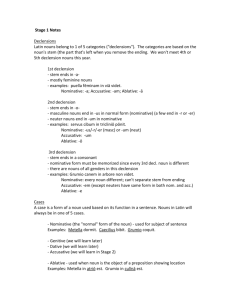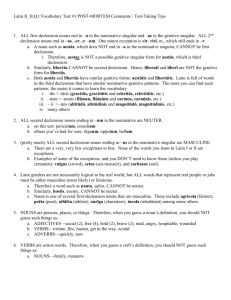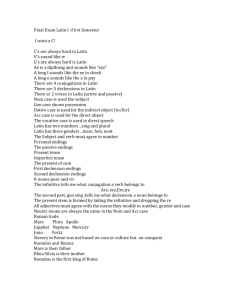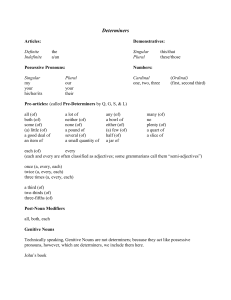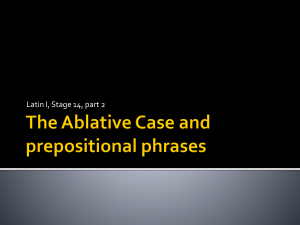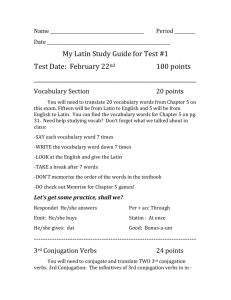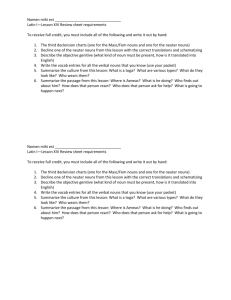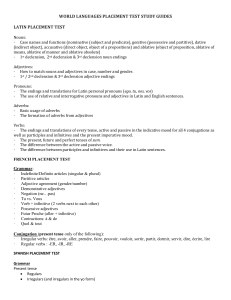Latin 1 - WordPress.com
advertisement
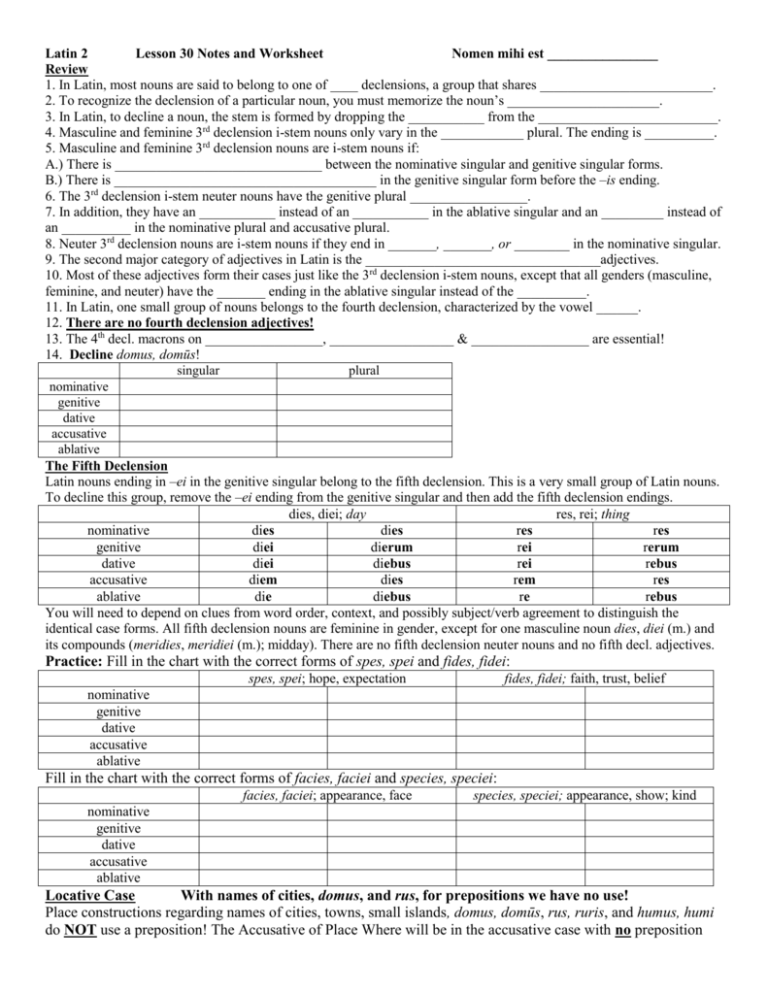
Latin 2 Lesson 30 Notes and Worksheet Nomen mihi est ________________ Review 1. In Latin, most nouns are said to belong to one of ____ declensions, a group that shares _________________________. 2. To recognize the declension of a particular noun, you must memorize the noun’s ______________________. 3. In Latin, to decline a noun, the stem is formed by dropping the ___________ from the __________________________. 4. Masculine and feminine 3rd declension i-stem nouns only vary in the ____________ plural. The ending is __________. 5. Masculine and feminine 3rd declension nouns are i-stem nouns if: A.) There is ______________________________ between the nominative singular and genitive singular forms. B.) There is ______________________________________ in the genitive singular form before the –is ending. 6. The 3rd declension i-stem neuter nouns have the genitive plural _________________. 7. In addition, they have an ___________ instead of an ___________ in the ablative singular and an _________ instead of an __________ in the nominative plural and accusative plural. 8. Neuter 3rd declension nouns are i-stem nouns if they end in _______, _______, or ________ in the nominative singular. 9. The second major category of adjectives in Latin is the __________________________________adjectives. 10. Most of these adjectives form their cases just like the 3rd declension i-stem nouns, except that all genders (masculine, feminine, and neuter) have the _______ ending in the ablative singular instead of the __________. 11. In Latin, one small group of nouns belongs to the fourth declension, characterized by the vowel ______. 12. There are no fourth declension adjectives! 13. The 4th decl. macrons on _________________, __________________ & _________________ are essential! 14. Decline domus, domūs! singular plural nominative genitive dative accusative ablative The Fifth Declension Latin nouns ending in –ei in the genitive singular belong to the fifth declension. This is a very small group of Latin nouns. To decline this group, remove the –ei ending from the genitive singular and then add the fifth declension endings. dies, diei; day res, rei; thing nominative dies dies res res genitive diei dierum rei rerum dative diei diebus rei rebus accusative diem dies rem res ablative die diebus re rebus You will need to depend on clues from word order, context, and possibly subject/verb agreement to distinguish the identical case forms. All fifth declension nouns are feminine in gender, except for one masculine noun dies, diei (m.) and its compounds (meridies, meridiei (m.); midday). There are no fifth declension neuter nouns and no fifth decl. adjectives. Practice: Fill in the chart with the correct forms of spes, spei and fides, fidei: spes, spei; hope, expectation fides, fidei; faith, trust, belief nominative genitive dative accusative ablative Fill in the chart with the correct forms of facies, faciei and species, speciei: facies, faciei; appearance, face species, speciei; appearance, show; kind nominative genitive dative accusative ablative Locative Case With names of cities, domus, and rus, for prepositions we have no use! Place constructions regarding names of cities, towns, small islands, domus, domūs, rus, ruris, and humus, humi do NOT use a preposition! The Accusative of Place Where will be in the accusative case with no preposition and the Ablative of Place from Which will be in the ablative case with no preposition. The Ablative of Place Where for just these names of cities, towns, small islands, domus, domūs, rus, ruris, and humus, humi will be in the Locative case with no preposition. The Locative case for these words is: 1st declension: exactly like the dative form! 2nd declension: exactly like the genitive singular form for the singular, like the dative plural for the plural! 3rd declension: exactly like the dative form! domus, domūs: domi Practice: Give the Locative for the following words: 1. Roma, Romae ____________________ in Rome 2. rus, ruris ____________________ in the country, at one’s country place 3. humus, humi ____________________ on the ground 4. domus, domūs ____________________ home, at home Supine One of the uses of the fourth principal part of a verb is what is called the supine. Certain verbs like sum that have fourth principal parts in –urus, -ura, -urum, do not have a supine. There are two types of supine: commonly known as the supine in –m (the accusative) and the supine in –u (the ablative). Each of these two types has a limited and very specific use. The supine in –m is used with a verb of motion to express purpose. This is the most common use of the supine. Domum visum ambulavit. He walked to see the house. The supine in –u is far less common and used with very few verbs: auditu (audio), dictu (dico), factu (facio), inventu (invenio), visu (video), and memoratu (memoro). This use of the supine is an example of the ablative of specification. It is used mainly with adjectives, sometimes with nouns (fas, nefas) and very rarely with verbs. Quae res inventu facilis non est? What thing is not easy to find? Practice: Fill in the chart with the correct forms of the supine in the accusative singular and ablative singular: verb accusative singular supine ablative singular supine supine translation audio, audire, audivi, auditus facio, facere, feci, factus invenio, invenire, inveni, inventus video, vidēre, visi, visus So we have learned that: 1. Latin nouns ending in –ei in the genitive singular belong to _____________________________________________. 2. To decline the 5th decl., remove ______ ending from _______________ and then add ____________________ endings. 3. All fifth declension nouns are ______________ in gender, except for the masculine ____________ and its compounds. 4. There are no fifth declension __________ nouns and no _____________________________________. 5. With names of cities, domus, and rus, for prepositions we have no use! 6. Place constructions regarding names of cities, towns, small islands, domus, domūs, rus, ruris, and humus, humi do ______ use a preposition! 7. The Ablative of Place Where for just these names of cities, towns, small islands, domus, domūs, rus, ruris, and humus, humi will be in the ____________ case with ______ preposition. 8. The Locative case for these words is: 1st declension: exactly like _____________________________! 2nd declension: exactly like ___________________________________________________________________! 3rd declension: exactly like _____________________________! domus, domūs: _______________ 9. One of the uses of the fourth principal part of a verb is what is called the ____________. 10. There are two types of supine: the supine in –m (____________) and the supine in –u (_______________). 11. The supine in –m is used with a verb of ___________________ to express __________________. 12. The supine in –u is used with very few verbs: auditu (audio), dictu (dico), factu (facio), inventu (invenio), visu (video), and memoratu (memoro). This use of the supine is an example of the ablative of specification. It is used mainly with adjectives, sometimes with nouns (fas, nefas) and very rarely with verbs.

